The Birth of 100-Mile Trail Racing
and
Seeds That Grew Into the Wasatch 100
by Dana Miller
Western States 100 Mile Endurance Run
In 1974, Gordy Ainsleigh ran what would later become the Western States 100. Gordy was an experienced long distance horse rider, having completed the 100-mile Tevis Cup endurance ride. In 1973, Gordy’s new horse came up lame just prior to the race. With encouragement of a Tevis Cup board member, he decided to try covering the course on foot the next year (1974), competing with the horses. He finished in 23 hours, 42 minutes.
This was, perhaps, the beginning of 100-mile trail racing’s “gold standard” of running a sub-24-hour race…100 miles in less than one day.
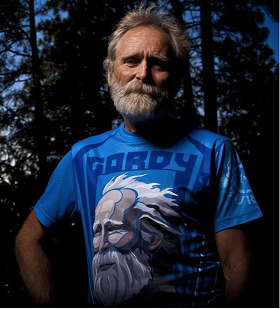
Gordy Ainsleigh (photo from An Interview With: Gordy Ainsleigh – Sofa to Ultra, May 27, 2015).
One runner attempted the same feat in 1975, dropping out at 98 miles. In 1976, infamous Ken “Cowman” Shirk completed the Tevis Cup on foot in about 24 hours, 30 minutes. In those days, Cowman was known for wearing a buffalo horn headdress during races. I first met Cowman when we both did the 1982 Hawaii Ironman and, sure enough, even his bike helmet had fur and buffalo horns! I didn’t see his swim cap.
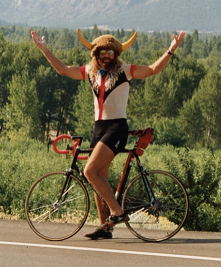
Ken “Cowman Shirk” (photo from Episode 6 – The Aloha Years – SHY GIANTS)
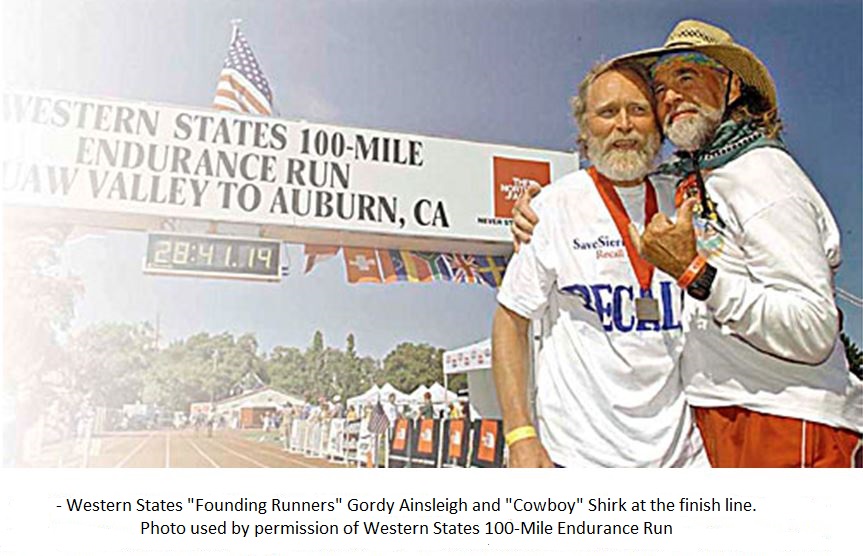
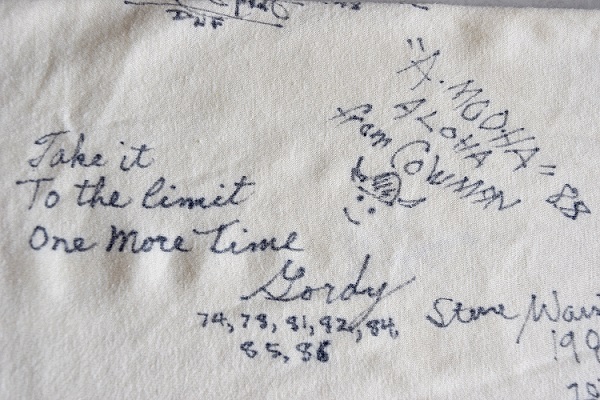
Western States 100 “Founding Runners” Gordy Ainsleigh and “Cowman” Shirk
kindly autographed my t-shirt at the finish of the 1988 Western States 100.
The first official Western States 100 was in 1977, when 14 men found their way to the starting line. It was still held in conjunction with the Tevis Cup. One runner finished in under 24 hours and two more in 28 hours, 26 minutes…perhaps establishing the sub-30 hour award.
The following year (1978), Western States moved to the race to June. It seems that 100-mile trail racing was beginning to catch on as 63 runners started the race. The following year (1979) saw the race field more than double to 143.
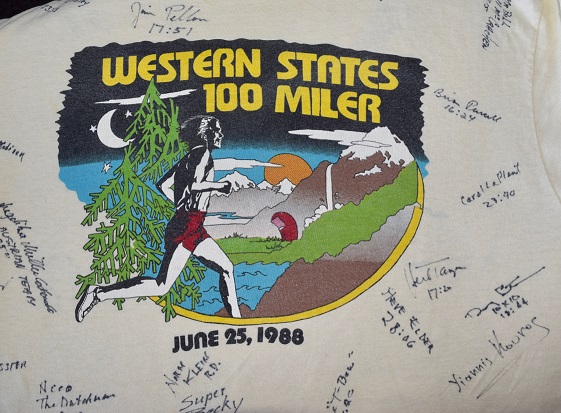
T-shirt from my first Western States in 1988. Winner Brian Percell’s (16:24) is at the top right; Herb Tanzer, at the right of the logo, was 2nd (17:51),; and Jim Pellon (top just above “Western”) was 4th. Norm Klein, the race director, signed just below the date. You can just see “Super Becky” below Norm’s signature. Becky Nielsen won Wasatch in 1986 and ran several of the pre-Wasatch races. Ultrarunning legend Yiannis Kouros’ autograph is at the lower right corner. I finished 26th in 20:28 and learned a lot that would help me run faster the next time.
Old Dominion
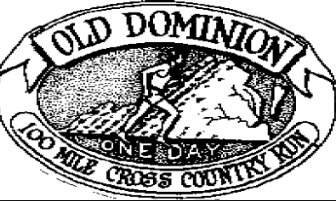
Meanwhile, on the East Coast, the Old Dominion 100 kicked off in 1979 with 45 runners. The Old Dominion race originated with Pat and Wayne Botts, whose goal was to give east coast runners an opportunity to cover 100 miles on trails in the rugged mountains of Northern Virginia. Initial support, interestingly enough, came from the endurance horse riders who held their own first 100-mile ride in 1974.
The Old Dominion 100 didn’t experience the same explosive growth witnessed at Western States. 1980 saw 49 starters and in 1981 only 38 started the race.
The Wasatch 100’s Roots
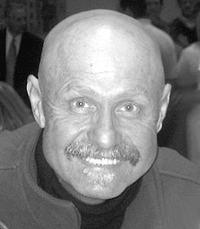 Richard Barnum-Reece
Richard Barnum-Reece
(photo from his obituary, published in the Deseret News, Feb. 2-3, 2008)
When Richard Barnum-Reece dreamed up the idea of an inaugural Wasatch Front 100 Mile Endurance Run in 1980, it seems that a few hallmarks of modern 100-mile trail running were already in place. First was the 24-hour “gold standard” inherited from California’s Tevis Cup endurance horse ride. Second was the concept of a 30-hour cut-off time, arguably an outgrowth of the first official Western States 100 2nd and 3rd place finishers’ times of 28:26. (Old Dominion adopted a 30-hour time limit in 1985 and, interestingly, Wasatch had a 30-hour cut-off in 1981). Finally, because the Tevis Cup awarded finishers a “cowboy style” belt buckle (which was entirely appropriate for the equestrian community), Gordy Ainsleigh earned one in 1974. Thus, the belt buckle also became the official 100-mile run finisher award, a tradition followed by most hundred-mile races to this day.
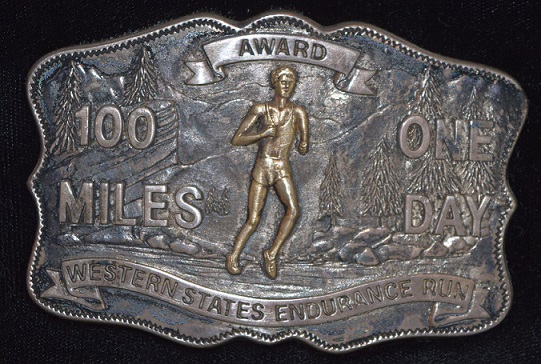
My first Western States silver buckle, 1988.
That brings us back to Richard Barnum-Reece. Former University of Utah football player. Newspaper reporter. Self-described “reformed career drinker”. Sports magazine founder and editor. Skier. Entrepreneur and eternal promoter. Eventual finisher of 29 marathons, seven 50-mile runs and one 100-miler. A true larger than life character who, when he died in 2008, had already written his own obituary “so no one would screw it up.”
I don’t know when Richard started running. I first met him in 1981 in his official capacity as new race director of the Bair Gutsman. To me, at about 200 pounds, he looked more like a burly rugby player than a runner but he had an unmistakable twinkle in his eyes that let me know he was passionate about life and loved to have fun.
The Bair Gutsman, although originated by Jan Cheney, was Richard’s kind of race. It started with Bair Canyon’s 4300’ elevation gain in 4 miles with virtually no trail (in 1980 when I first ran it). It was so ridiculous…I remember clawing my way uphill through 10-foot high chaparral and scrub maple amidst the constant call of “Have you got a trail over there?” from other runners. Richard relished that sort of thing… wild, unpredictable and memorable enough to become legendary. It was as though he expected us to get hurt, to blame him for it, but also to love it.
Although it’s been more than 35 years, I still vividly remember my first Richard Barnum-Reece encounter. I had opted to do the Bair Gutsman’s 29-32 mile “long course” (it depended on who you asked), adding about 20 miles to the usual 11-mile event. After hurdling the forest service gate to finish the shorter race in 10th place, I set off up the gravel road towards Bountiful Peak already pretty dehydrated from that near all-out effort. As I descended off the south side of Bountiful Peak to what Wasatch calls “Bountiful B”, I still hadn’t found any of the plastic water jugs Richard promised the 5 “long course” competitors would find on the side of the road at 4-5 mile intervals. By the time I reached the finish at the “B” east of Bountiful, I was badly dehydrated, having found only 1 partial jug of water during those additional 20 miles. In those days, I, along with virtually everyone else, didn’t wear a water bottle pack (they hadn’t been invented) nor did I even carry a “bike” water bottle.
Richard showed up in a Jeep-type vehicle (they weren’t called SUV’s yet) within a few minutes of me finishing (in 5:02) to give the “long course” runners a ride back to the start where our vehicles were parked. When we chided him about the lack of water, he just laughed and said: “Those son-of-a-bitch motorcyclists must have kicked the water jugs off the road!” It was kind of funny and no one was upset. It felt more like we were ultimately responsible for our own fluids and that his efforts to provide water were a bonus rather than something any of us depended on for our well-being.
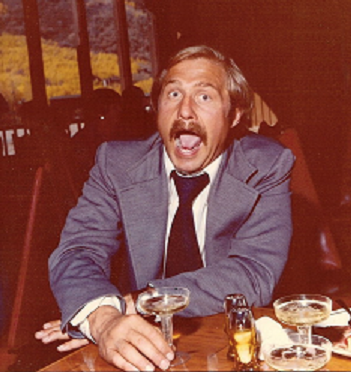
This is the Richard Barnum-Reece I knew!
Believe it or not, this is the photo submitted for Richard on Find A Grave!
Little did I know that Richard had given me sneak peek of his view of what trail racing should be and how the Wasatch 100 embodied that “you signed up for this” perspective.
I suspect Richard was the “perfect storm” to launch the Wasatch 100. He loved outdoor adventure. He was a runner of sorts. He wasn’t content with the conventional. He tended towards outlandish exploits. He had that indomitable “can do” entrepreneurial spirit that was infectious. He was a salesman. Why not take on the task of putting on a 100-mile mountain race? Just think how crazy and fun that would be!
Richard Barnum-Reece had crossed running paths with Steve Baugh during Richard’s Flight of the Eagle and Park City 40-mile events. Given that there were very few “trail” runners and far fewer “ultra” trail runners in Utah in 1980, it follows that most “ultra” distance events only attracted a handful of runners. That handful of runners tended to show up at the same events, lending to the development of a close knit “ultra” community. For whatever reason, when Richard was ready to share his dream of staging a 100-miler in Utah’s Wasatch mountains, he approached Steve Baugh with the idea and asked Steve if he’d be willing to help lay out a course. Steve agreed to take on the task.
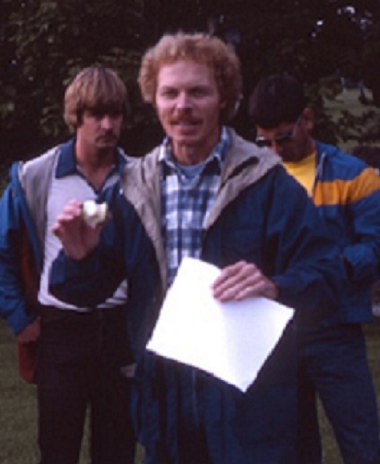
Steve Baugh (1982)
Photograph by Mary Dewell. Courtesy of Ben Dewell.
Excerpt from Steve Baugh interview 1-31-17. Steve Baugh (Wasatch 100 race director from 1981-1987) talks about Richard Barnum-Reece approaching him with the idea of doing a 100-miler in the Wasatch Mountains.
Audio Player
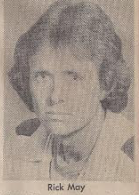
12-time Wasatch 100 finisher in 1981. Photo from Ogden Standard-Examiner article “Rick plans to run to Denver”, April 16, 1981.
Excerpt from Rick May interview 2-16-17, during which he shares his interactions with Richard Barnum-Reece. Rick started running in 1974 and did his first trail race, the Bair Gutsman, in 1977. His first Wasatch 100 was in 1983. He went on to finish Wasatch 12 times and still thinks he’s got one more left in him.
Audio Player
And so the seeds of the first Wasatch Front 100 Mile Endurance Run took root.
Next up: The First Wasatch Front 100 Mile Endurance Run (1980)
© 1980
